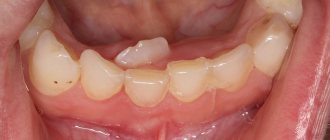Good day, dear readers. If you have young children, then most likely you have heard about different dental procedures for them. Many parents who complain about the poor condition of their children’s teeth can be offered options for solving this problem. Among them is such a popular technique as silvering teeth.
Silvering of baby teeth
As is known, the chemical element silver (Ag) has antibacterial properties, and the main cause of tooth decay, caries, is caused precisely by their activity. Of course, there are other reasons, including demineralization, which we will also look at as we study this topic.
Silvering and fluoridation of baby teeth
Why are teeth silvered in childhood?
Very often in order for frightened mothers to calm down at least for a while. The fear that a child's teeth will deteriorate/fall out prematurely haunts many young parents. After all, this is quite real and they see examples of similar situations among the children of their neighbors, acquaintances, and relatives.
Silvering of teeth in children
If we talk about a medical point of view, it is believed that silvering baby teeth helps in the prevention of caries and even stops its development in the initial stages. As practice shows, this technique often turns out to be quite effective.
What is silvering of teeth
Did you notice that I wrote “often”? The fact is that there are no two identical children who would be affected 100% equally by any method/drug used in medical practice. Pardon the tautology, but I can’t describe this simple fact any other way.
When silvering occurs, tooth enamel becomes noticeably darker. Therefore, this method is used for baby teeth, which will eventually fall out anyway.
Silvering teeth for children
For permanent teeth, this method of prevention is pointless. After all, the surface of the treated tooth does not look aesthetically pleasing at all.
Having discovered obvious signs of caries in their baby, parents run to the children's dental clinic or to private doctors with a request to stop the destructive process. It is very important that the child does not lose his baby teeth. This is where the pediatric dentist needs to decide whether to fill the tooth or silver plate it. For the front incisors, a filling is not the best option. She is holding up extremely poorly. The professionalism of the dentist plays a very important role. He should not choose a technique according to the principle “the more expensive, the better.”
Children's teeth after silvering procedure
Tips and tricks
- In order not to guess whether baby teeth need to be silvered or whether it is better to give preference to fluoridation and remineralization, it is necessary to show the young patient to the dentist. After the examination, the doctor will give a professional opinion on the condition of the oral cavity and advise which methods of combating the disease are best suited for a particular patient.
- Light inclusions or spots on the enamel are a sign of caries in the white spot stage. At this stage, doctors recommend using toothpaste with fluoride to cleanse teeth; this is usually enough to relieve the disease. You can also resort to remineralizing therapy, fluoridation and silvering.
- If the carious lesion affects only the tooth enamel, it is better to resort to fluoridation or remineralizing therapy. It is possible to silver your teeth, but the effectiveness of the procedure will be low.
- With average caries, silvering “delays” the development of pulpitis. But according to doctors, the most effective method of combating the disease at this stage is treatment and installation of a filling.
The best solution when detecting a carious lesion on a baby tooth is treatment and installation of a filling. But in cases where the baby does not make contact with the dentist, silvering procedures or alternative methods are recommended.
Causes
Why does the problem itself arise? It varies from person to person, but most often it’s due to diet and poor oral hygiene. For example, you give sweet juices and lemonades, especially at night. The result is obvious - caries. Does your child eat sweets and cakes? Sugars and carbohydrates are excellent “food” for bacteria that destroy his teeth.
What you can and cannot feed your baby at night
If the diet lacks calcium, vitamin D and other substances valuable for teeth, this can also cause destruction of enamel and other tissues.
- Silvering of baby teeth
Caries of baby teeth
Sometimes babies can have congenital enamel defects. In these cases, silvering is used to prevent future problems. But don’t be lazy to ask what else you need to do to protect fragile teeth.
Causes of caries in baby teeth
Why do children get tooth decay?
There are many reasons for the development of carious formations:
- Insufficient mineralization of enamel. Baby teeth have porous enamel, which makes it more susceptible to destruction by cariogenic organisms. To strengthen the enamel, it is necessary to ensure that the child eats properly and receives all the necessary substances; a fluoridation procedure can also be recommended.
- Poor hygiene, exacerbated by the large amount of sweets and carbonated drinks with high sugar content consumed.
- Eating food contaminated with cariogenic bacteria. This happens when parents lick the spoon with which the child will later eat, or kiss him on the lips.
- Violation of feeding regime. You should not give food to your child at his first request. It is also forbidden to keep a bottle of sweet liquid near the baby’s crib, giving him the opportunity to constantly drink sugary drinks that destroy his teeth.
How is the teeth silvering procedure performed?
The doctor uses silver nitrate AgNO₃. Of course, not in its pure form, but in the form of a 30% solution. There are also more modern preparations that combine fluoride and silver. They have a pronounced effect in the fight against carious bacteria.
Silvering process
How it works? The drug forms a film of solid insoluble salts on tooth enamel, which not only defeat bacteria, but also prevent the destruction of the enamel even if there are spots on it (demineralization or the initial stage of caries).
The drug is applied for a few minutes, so it does not cause any discomfort. Complete painlessness is guaranteed during the use of the active ingredients.
Silvering of baby teeth
Video - Treatment of caries of temporary teeth using silver impregnation method
Advantages and disadvantages of the procedure
Silvering has both supporters and opponents. Among the arguments in favor of carrying out the procedure:
- minimum stress for the child due to painlessness;
- speed of the procedure;
- safety (natural ingredients are used);
- price. Of the possible alternatives for restoring enamel, this is the most affordable.
- no need for pain relief or anesthesia;
- delay of illness. For some parents, the decisive factor is precisely the temporary one, since it makes it possible to wait until the child psychologically matures to another method of treatment. In this case, the disease will not progress.
The disadvantages include:
- aesthetic aspect, or “black” smile. The more teeth are silvered, the more noticeable the effect of the treatment. This is not acceptable for all children (and sometimes parents).
- short duration of action. Silvering is a safe procedure, but it does not last long. Over time, the silver nitrate film deteriorates, losing its protective properties. Therefore, there is a need to repeat the procedure.
- Silvering does not work for all caries. When a child has developed moderate caries or the degree of damage is already deep, this method will not work (the solution, when it gets on severely affected areas, harms the pulp) - it is necessary to look for other ways to solve the problem.
How often do you need to silver your teeth?
According to pediatric dentists, the most effective effects of drugs containing silver are as follows:
- repeat silvering of teeth 3 or 5 times;
- this can be done in a row or every other day;
- It is optimal to do this every 4 months. If this is not possible - twice a year.
Silvering teeth in children has a positive effect in terms of protecting not only hard tissues (enamel), but also soft tissues (dentin). The frequency of repetition of procedures is individual for children of different ages. It also depends on how well oral hygiene is implemented and whether the child is fed naturally.
Boy with silvered teeth, teeth after silvering
Indications and contraindications
Silver treatment of baby teeth is indicated for children in several cases:
- thinning of tooth enamel and the presence of small defects - chips, microcracks;
- in the presence of carious formations in the white spot stage;
- to prevent the development of infection and proliferation of pathogens;
- to extend the service life of the filling;
- with increased sensitivity of the gums to temperature changes.
Silvering of teeth is performed on children to prevent recurrence of caries, however, if the damage has spread not only to tooth enamel, but also to dentin, then the procedure is strictly contraindicated.
Important! Dentin is a layer of tissue located under the tooth enamel. In children, dentin has a soft and loose structure, so caries spreads very quickly in it. If the lesion has progressed to the stage of medium caries, then treatment with silver should be carried out monthly, however, there is no absolute guarantee that the superficial destruction of dental tissues will not develop into pulpitis.
It is also unacceptable to silver tooth enamel if:
- components of preparations for coating enamel cause an allergic reaction in the baby;
- the young patient suffers from severe somatic pathologies;
- the baby has developed deep caries;
- patient over 3 years old.
Important! Doctors never recommend silvering the teeth of children who eat foods high in fluoride.
Silvering of teeth - expert opinions on the technique
There are many different opinions among dentists. They constantly argue, arguing for and against silvering teeth, citing research.
Fact one - silver nitrate, if it penetrates deep into the tooth tissue, can damage the pulp.
One-component argenate - material for use in the initial forms of development of carious processes (liquid 5 ml)
What do doctors suggest? Nowadays, there are a lot of combination drugs that are effective, but safer.
Fact two - combination drugs contain fluorides, which, according to some scientists, can be harmful.
Benefits of silvering teeth
Dentists have differing opinions. Some say that the dose of this halogen is insignificant and cannot harm a person. Others argue that even microdoses that exceed the body's actual needs are a health threat.
- Silvering of teeth in children
- If caries has affected the chewing teeth, the procedure is unlikely to be beneficial.
- With advanced caries, there is also no guarantee that silver nitrate will be able to stop the process.
- Do not forget that the surface of the enamel will be covered with a brown or even black film.
Silvering of baby teeth “Pros” and “Cons”:
| Positive facts | Negative arguments |
| By silvering baby teeth in children, the procedure of drilling with a drill and further filling can be postponed until the future. Carious destruction is stopped | This procedure is not effective on the chewing part of the teeth and prevents the detection of caries. |
| The film formed on the surface layer of enamel after silvering protects against plaque and the proliferation of pathogenic bacteria | Silver teeth, when exposed to light, take on a dark tint. |
| The silvering procedure is simple and painless, and does not cause discomfort to the child. | In the stage of advanced caries, silver treatment is ineffective and can cause harm |
| The silvering workflow will not take much time. Small children can easily withstand and tolerate this procedure. | Thoroughly cleaning a child's teeth is an extremely difficult task. And before silvering, this action is necessary |
| Lowest price | To achieve the effect, you need to repeat the procedure more than once a year. |
Therefore, before going to the doctor, think about whether it is worth silvering your teeth or using another technique. As long as there is a small white spot on the tooth, it is not at all necessary to resort to radical measures. It may make sense to start the demineralization procedure. There are special products applied to the enamel for this purpose. You also need to make sure that the child brushes his teeth and eats properly.
Silvering of teeth in children
In the USA and most European countries, this technique is no longer used, being considered outdated. In the CIS, there are still few worthy alternatives that would be sufficiently effective and would not have side effects.
Do not forget that before applying silver preparations, soft and hard deposits must be completely removed from the teeth. When a three-year-old child sits in a dental chair, this is very problematic. He will spin around, avoiding what he considers “scary” medical instruments.
You cannot apply Saforite, Argenate or other products to unbrushed teeth. These two drugs are silver fluoride diamine - combination drugs that are considered the most modern and safe.
"Argenat"
It's important to know that. Unlike fluoridation, silvering teeth yourself at home is contraindicated. Considering that this procedure is not the most expensive, there is no point in violating the instructions of experts and self-medicating.
Alternative to silver plating
Many parents are confused by the disadvantages of this procedure. But dentistry, like other areas of medicine, does not stand still. It is developing, and more and more new techniques are appearing to combat tooth decay.
Fluoridation
Doctors recommend fluoridating enamel only to treat caries in the white spot stage. The purpose of deep fluoridation is to saturate weakened areas of tooth enamel with fluoride; this manipulation increases its hardness and reduces calcium leaching.
Remineralization
The purpose of the procedure is to saturate weakened areas of enamel with calcium and other minerals. The therapy is effective if the teeth are thoroughly cleaned of bacterial plaque and tartar. The procedure is indicated for children with caries in the form of chalky spots on the surface of the enamel; sometimes healthy primary incisors, fangs and molars are subjected to treatment for the purpose of prevention.
Remineralizing gels can be applied at home, but it is better to have the procedure done at a dental clinic. Before the procedure, the dentist must thoroughly clean the tooth surface using special pastes and polishing brushes for more effective penetration of calcium, and only then treat it with preparations.
In the presence of carious lesions penetrating into the dentin layer, remineralization, fluoridation and silvering are useless.
Other dental protection options
Most often, if there are no holes or significant damage on the tooth, experts may recommend fluoridation - regular or deep. Special pastes and other means are also selected to help stop the process of enamel destruction.
Fluoridation of teeth
The use of sodium fluoride is a popular alternative to silver plating, but this method is not a panacea. In addition, if your region has fluoridated water or there is a company whose activities are somehow related to fluoride emissions, the use of such techniques may even be dangerous. After all, poisoning with fluoride compounds causes fluorosis and other diseases.
In addition, fluoridation can only be done after 2 years, when the enamel is formed and strong enough. Otherwise, fluoride will cause a reverse reaction - softening of tooth tissue, which will accelerate their destruction.
Fluoridation of teeth in children
When choosing a technique, much depends on the professionalism of the doctor. His task is to determine which method will be relevant for each specific patient.
- Silvering of teeth in children
Video - Other options for protecting teeth
Minuses
- If you neglect to thoroughly clean your teeth before the procedure, it may not give the desired effect.
- After silvering at the site of application of the drug, the enamel acquires a stable dark or black color if solutions produced in Belarus and Russia are used. Treatment with Japanese “Saforaid” gives the teeth a light gray or brownish tint. It is impossible to return the previous whiteness. The blackening of teeth in the photo before and after silvering often makes parents doubt the need for the procedure.
- Treatment is time-consuming and the process cannot be completed in one day.
- There is a risk of pulp burns and allergies.
- Silver plating is not suitable for chewing teeth.
Silvering of teeth - what do parents write?
Having studied numerous reviews about teeth silvering written by mothers of babies, I came to the conclusion that doctors often prescribe this procedure simply for the sake of money. That is, they do this, fully aware of the fact that this will not help the child.
Child at the dentist
Not everyone wants their child to walk around with black teeth. Adults don’t care, but other kids will tease you. They don’t understand what this treatment is. Therefore, many mothers and fathers do not take risks, realizing that their teeth will not completely change tomorrow or even in a month. If a child goes to kindergarten and is the only one there with such teeth, expect to come home in tears.
The second point is the hereditary factor. It, like various situations during pregnancy, can affect the destruction of baby teeth no less than caries. No amount of silver will help you here. Many parents and dentists are faced with this problem, either they shrug their shoulders or use fluoride and silver on the principle of “what if it helps.”
Silvering does not always help
The third point is stress. Of course, silvering your teeth doesn’t hurt. Only now, if you are bringing a baby to the doctors who is barely one and a half years old, he will be very nervous.
There are also those parents who are delighted. They had the procedure done on time and, apart from black teeth, there were no negative consequences. The caries stopped, which means the method helped them. There are as many such reviews as those that talk about the uselessness of using this method.
Many children suffer from mineral imbalances. Without understanding it properly, dentists prescribe silver plating. Of course, there is practically no benefit from such work. After all, the problem is “internal” and has nothing to do with caries. Therefore, the destruction continues. To help a child in such circumstances, you need a competent, and most importantly, comprehensive approach, including:
- diet correction;
- prescription of vitamin and mineral complexes;
- external use of pastes and other means of demineralization of enamel;
Girl at the dentist
The most interesting thing is to read how, under pressure from worried parents, permanent teeth are silvered for seven-year-old children. This is nonsense and should not be done under any circumstances. Especially when it comes to caries of permanent teeth. They will not change and will remain black forever! It will be very difficult for the child when he grows up. What to do next? Should I get crowns or veneers after 18 years of age? Don't create additional problems for your children in the future.
Oral hygiene is very important
You can also advise trivial but important things - no matter how capricious children are or struggle, you should brush their teeth twice a day. Choose a good brush and toothpaste. When they grow up, they will thank you for healthy teeth. Do not give them sweets at night, do not feed them, do not give them juices. All these typical mistakes of parents always end equally badly.
Advantages of the technique
When talking about the benefits of silvering as a method of caries prevention, it is customary to emphasize the following:
- the child does not experience pain;
- the service is cheap;
- the composition used is safe for health;
- therapy takes little time;
- no need to use local or general anesthesia;
- it is possible to extend the service life of milk units.
Despite all these advantages, silver plating is used less and less today. And there are reasons for this.
Optimal age for treatment
Doctors advise silvering the teeth of children under three years of age. This is due to the fact that at this age children very often refuse to undergo regular dental treatment and are terrified of drills and other dental instruments.
With children four years old and older, doctors most often manage to come to an agreement. Doctors offer them gentle filling techniques, during which they almost never experience any discomfort. But, if the child is emotionally unstable, the need for silver application may arise even at age five.
Technique of the procedure
The method of silvering has not undergone any changes over a long time. Impregnation of primary teeth is carried out in the following order:
- Selection of the drug. The list of medications used in this method is extensive. The main active ingredient included in the solution is 30% silver nitrate. In addition, you need a special Vaseline-based oil that protects the gum mucosa during processing.
- Cleaning the enamel with brushes and applying abrasive paste. It is performed to free the surface of the tooth from plaque, microorganisms and dead particles.
- Rinsing the mouth from the toothpaste with water.
- Protection from saliva using cotton swabs, drying the mouth with warm air.
- Treating gums with Vaseline oil to prevent burns.
- Applying a solution containing silver using a dental applicator (microbrush). The treatment is carried out locally, avoiding contact of the drug on the gums. After a few minutes, the procedure is repeated, then the reducing agent is applied.
- At the final stage, the silvered surface is dried with warm air. A sign of a correctly performed procedure is the appearance of black enamel at the site where the solution was applied.
It is not recommended to rinse your mouth, eat or drink for 40–60 minutes after treatment.
Psychological side of the issue
Children don't often look in the mirror and think about what color their teeth should be. But black spots can be indicated by other kids who keep the child company in kindergarten, on the playground or in a development center. Therefore, before silvering a tooth, it is advisable to talk to the baby and tell him what changes are coming and why this is necessary.
The child must understand that the “silver” on the enamel reliably protects it from the harmful effects of infection. It doesn’t matter what teeth that have begun to turn black look like, the main thing is that if you don’t take action, they can start to hurt and fall out.
If a child is teased, he may experience stress. To repel ridicule, the baby can answer that his teeth have silver, not black, marks.
Important! When asked by a child when the blackness will pass, it is better to answer honestly that the dark spots will persist until new incisors and molars begin to grow.
Are you planning to have your child's teeth silvered?
- Yes, I plan 58%, 14 votes
14 votes 58%14 votes - 58% of all votes
- Don't know yet 29%, 7 votes
7 votes 29%
7 votes - 29% of all votes
- No, I'll choose another 13%, 3 votes
3 votes 13%
3 votes - 13% of all votes
Total votes: 24
21.09.2018
×
You or from your IP have already voted.
How Reconstituted Silver Works
The composition impregnates dental tissues, due to which they become denser and more resistant to negative external factors. With initial and superficial caries, the medicine penetrates deep into the pores of the enamel and, as it were, clogs them.
The drug not only increases the stability of dental crowns, but also has a pronounced antibactericidal effect. With its help, you can disinfect your mouth and destroy pathogenic flora in a carious cavity. But to achieve maximum results, one treatment is usually not enough - it must be repeated several times.
Is it possible to do silver plating at home?
At first glance, there is nothing complicated or dangerous in the procedure. But, despite the fact that the child feels calm at home, applying the drug on his own is strictly prohibited, and here’s why:
- It is difficult for a person far from medicine to determine the extent of enamel damage. Penetration of silver solution into soft tissue can lead to pulpitis.
- If silver solution gets on the mucous membrane as a result of inept actions, it causes a burn.
- Without special skills and tools, it is difficult to properly clean the surface of a tooth; unremoved plaque will negate all efforts.
- If an allergic reaction occurs, medical attention may be needed immediately. It is difficult, often impossible, to provide it at home.











